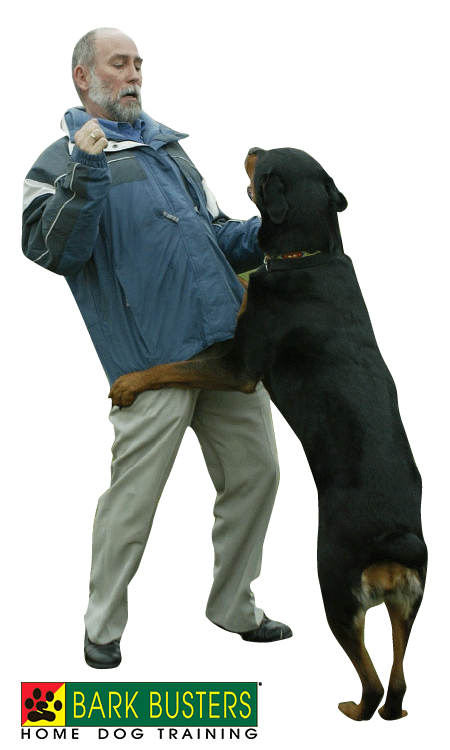Jumping Up - Dog Training Tips
 We often get called to see dogs who are in the habit of jumping up at people. It may be that they jump up at their owner, or visitors, or anyone they pass in the street! It’s a behaviour that can be, at best, embarrassing for the owner or, at worst, putting the owner at risk of criminal charges and an expensive fine.
We often get called to see dogs who are in the habit of jumping up at people. It may be that they jump up at their owner, or visitors, or anyone they pass in the street! It’s a behaviour that can be, at best, embarrassing for the owner or, at worst, putting the owner at risk of criminal charges and an expensive fine.
When dogs greet each other (besides the rear end sniffing), they do so face to face. This is the accepted etiquette between dogs. The problems arise when your dog offers this behaviour to all humans he wants to say hello to. Jumping up at you in order to get his face close to yours is not good manners in the human world, and it certainly won’t go down well when your dog chooses to do this to the first person he passes after a run through a muddy field! So jumping up to say hello is a prime example of a behaviour where communication is key to teaching your dog that what is acceptable in the dog world is not acceptable in the human world.
To avoid confusing yourself as to how far your dog needs to go before his behaviour is considered anti-social, apply this rule: “My dog should have four paws on the ground when greeting people”. This benchmark is completely unambiguous. It will eliminate any doubt in your mind, and will enable you to know exactly when to praise your dog. Even if you decide that your dog needs to be in a ‘sit’ in order to greet people, he will still have four paws on the ground.
So how do you teach your dog to stop jumping up? Bark Busters trainers do not condone using painful methods to deter a dog from unwanted behaviour, so we do not hold with methods such as kneeing your dog in the chest, or causing pain in any other way. These methods are cruel and do not communicate to your dog what you want him to do instead. Rather, we would suggest that you teach your dog through communication and leadership to offer an alternative behaviour, either standing or sitting, but with all paws on the floor. You must start simply, using yourself as the stooge. Teach your dog that he is highly praised when he remains on the ground, and that jumping up will earn him no attention from you other than a vocal correction. Be alert, and be ready to issue your vocal correction as soon as the paws start to leave the ground – don’t wait until his paws are on your shoulders to do this. As soon as his paws are back on the ground give lots of praise, but try not to be too physical with your praise as this may encourage him to jump again. By consistent repetition, teaching him that remaining in the sit or stand position when visitors arrive will earn him your praise, you are positively reinforcing that behaviour.
What you must understand is that we, as humans, often overcomplicate the communication between ourselves and our dogs and so we slow down the training process. When you set out to train your dog either in to or out of certain behaviours, you must be consistent. Dogs are consistent creatures who tend to respond in the same way to the same triggers. Humans are inconsistent, and respond differently to triggers depending on what mood we are in/how much time we have/ whether or not we can be bothered. By behaving inconsistently, you will only confuse your dog and slow down any progress. For example; you may accidentally encourage your dog in his jumping up habits by being animated and friendly when he does this to you, but then you might scream in horror when he does it to your five-year-old niece and knocks her over. The rule is simple…if you don’t want your dog to jump up at everybody then he must not jump up at anybody – including you. A dog cannot make the judgement as to who he can and cannot jump up at, so you must teach him never to jump up at anybody. He is greeted and fussed when he has four paws on the ground.
Spend some time putting your training into practise before you go out, or before visitors are due to arrive. Your dog will learn more quickly when there are few distractions and he is not excited, as he will be better able to listen to you as you teach him and praise him. Training your dog also helps you build a bond, entertains your dog, and teaches him to use his brain. A trained dog is a pleasure to be around.
If you need any help with this or any other issues, give us a call. Your local Bark Busters Home Dog Training therapist will be delighted to help you and teach you the techniques you need to cure your dog’s ‘anti-social’ behaviour.
Bark Busters trainers have trained more than 1 Million dogs worldwide and are renowned authorities in addressing dog behaviour with all-natural, dog-friendly methods. Bark Busters training is the only service of its kind that offers International guaranteed lifetime support. With hundreds of trainers around the world, Bark Busters continues its mission to enhance the human/canine relationship and to reduce the possibility of maltreatment, abandonment and euthanasia. Contact your local Bark Busters dog trainer to see how they can help.

0 comments:
Post a Comment